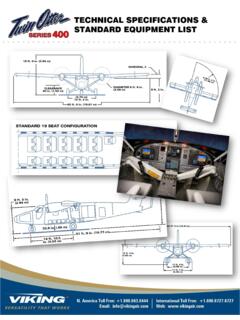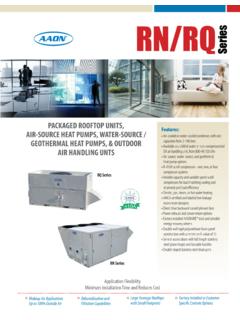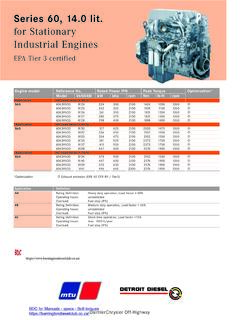Transcription of Twin Otter Series 400 - Viking Air
1 Twin Otter Series 400 North American Toll Free: + Toll Free: | 1965, de Havilland Canada developed the DHC-6 Twin Otter aircraft a high winged, un-pressurized twin engine turbine powered aircraft with fixed tricycle land gear. Designed as a rugged Short Take Off and Landing ( STOL ) commuter, the Twin Otter was capable of car-rying passengers and cargo into remote unimproved locations, including ski and water based operations. The aircraft were sold around the world to customers operating in the harshest environments, including sub-zero Antarctica, the hottest deserts of North Africa, the mountainous regions of the Himalayas, and the open water of the Indian Ocean archipelagos.
2 A testimony to its rugged construction and incredible STOL per-formance, the Twin Otter became the best-selling 19 passenger aircraft of all time, still unmatched for its dependability and versatility. The de Havilland Twin Otter experienced a production span of twenty-three years before the line was offi-cially shut down in 1988, after a total of 844 aircraft were delivered. The Legacy fleet , as it is now known, has remained in active use since the program end, carrying out jobs no other aircraft can do; in 2001, the Twin Otter was chosen as the only aircraft capable of performing an emergency evacuation flight of a critical patient from the South Pole under extreme -60 degree conditions.
3 This ability to reliably operate in any environment with minimal maintenance requirements has kept the legacy fleet at the forefront of niche markets around the world. It is often said that the only thing that can replace a Twin Otter is another Twin Otter , which explains the high demand in the market to keep the nearly 600 remaining legacy aircraft in 2005, Viking purchased the Type Certificates for all of the out-of-production de Havilland aircraft (DHC-1 through DHC-7), including the Twin Otter .
4 After an extensive market analysis was conducted, it was determined that an overwhelming demand existed to bring the Twin Otter back into production, thus the Viking Series 400 Twin Otter Production Program was announced in 2007. Combining a proven design with modern technology, the new Viking DHC-6 Twin Otter Series 400 will provide owners and operators with Versatility That Works .The Series 400 Twin Otter picks up where the original de Havilland Series 300 Twin Otter left off, introduc-ing upgraded Pratt & Whitney PT6A-34 engines, fully integrated Honeywell Primus Apex digital avionics suite, use of composite materials, and approximately 800 other modifications incorporated to improve upon the original production model.
5 However, like its predecessor, the Series 400 Twin Otter retains the ability to operate from remote and unimproved airfields due to its robust design, equalized main-tenance program, and dependability of the Pratt & Whitney engines. Available on standard land gear, optional straight or amphibious floats, skis, wheel skis, or intermediate flotation gear ( IFG ), with multiple quick-change interior configurations available, the Series 400 Twin Otter is a versatile aircraft that can be utilized for multiple roles, such as regional commuter, environ-mental monitoring, parachute operations, cargo and infrastructure support, corporate shuttle, crew car-rier, charter operations, and personal private use.
6 A military variant of the Series 400, the Twin Otter Guardian 400, has also been developed for mission-ization and varied Government operations. Offered as a versatile airframe that can be customized for unique configuration requirements, the Guardian 400 s low acquisition cost and flexible architecture allows oper-ators to mix and match sensors and interior layouts to meet their specific mission profiles. To date, Viking has sold Twin Otter Series 400 aircraft to military, commercial, corporate, and private oper-ators in 26 countries around the world.
7 The future promises to be exciting with continued aircraft deliv-eries, increasing the worldwide fleet of owners and operators who contribute to the ongoing de Havilland legacy every Information NOTE: Dimensions are approximate only and may vary depending on aircraft configuration selected and loading INFORMATION:Max. Takeoff Weight:12,500 lbs. (5,670 kg.)Max. Landing Weight:12,300 lbs. (5,579 kg.)Number of Crew: 1 or 2 Number of Passengers: 19 Fuel Capacities: Total 378 US Gallons (1,432 litres)Optional Long Range 89 US Gallons (336 litres)CABIN DIMENSIONS:Cabin Length: 18 ft.
8 5 in. ( m)Cabin Height: 4 ft. 11 in. ( m)Cabin Width: 5 ft. 9 in. ( m)Cabin Volume (usable): 384 cu. ft. ( cu. m)Cabin Doors (left side): 50 in. X 56 in. ( m x m)Cabin Door (right side): 30 in. X in. (.76 m x m)ENGINES:Two, Pratt & Whitney Aircraft of Canada Limited, PT6A-34, single stage, free-turbine :Configuration and Construction: All metal, non pressurized, high-wing monoplane with fixed tricycle (steerable nose) landing gear. PROPELLERS:Two Hartzell HC-B3TN three bladed reversible pitch, constant speed, fully feathering GREEN AIRCRAFT WEIGHT: 7,100 lbs.
9 (3,221 kg.)Clearance: 60 in. ( m)65 ft. 0 in. ( m)12 ft. 2 in. ( m)Diameter: 8 ft. 6 in.( m)DIHEDRAL 3 9 ft. 3 in.( m)20 ft. 8 in.( m)Clearance: in. (.65 m)19 ft. 6 in. ( m)51 ft. 9 in. ( )14 ft. in. ( m) in. (.85 m)9 ft. 8 in. ( m)19 ft. 6 in. ( m)Approx. at normal weightNOTE: All data is approximate and subject to change without SUMMARY: STOL Takeoff and Landing Distance Takeoff distance to 50 ft.: 1,200 ft. (366 m)Landing distance from 50 ft.: 1,050 ft. (320 m) Maximum Cruise Speeds, TAS Sea Level: 170 kt5,000 ft.: 181 kt10,000 ft.: 182 kt Enroute Rate of Climb at Sea Level(both engines at max.)
10 Climb power): 1,600 Service Ceiling (Rate of climb 100 ft/min)(both engines at max. climb power):25,000 ft. (7,620 m) Fuel Burn at Economy Cruise146 KTAS at 10,000 ft.: lbs/hour ( nm/lb of fuel) Payload Range at max cruise speedPayload for 100 nautical mile (185 km) range: 4,061 lbs. (1,842 kg.)Payload for 400 nautical mile (741 km) range: 3,031 lbs. (1,375 kg.) Maximum Range (Zero Payload)With standard tankage (2,576 lbs. (1,169 kg.) fuel): 799 nm (1,480 km)With long range tankage (3,190 lbs. (1,447 kg.) fuel): 989 nm (1,832 km) Maximum EnduranceWith standard tankage (2,590 lbs.







